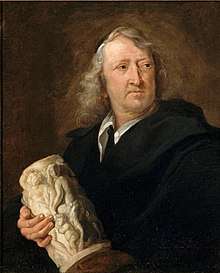Gerard van Opstal
Gerard van Opstal or Gérard van Opstal (1594 or 1597 in Brussels[1] – 1668 in Paris), was a Flemish Baroque sculptor mainly active in Paris. He was known for his low-relief friezes with classical mythological themes and his expertise in carving ivory reliefs.[2]

Life
He was born in 1594 or 1597 in Brussels or Antwerp as the son of Anton van Opstal.[3] He was trained around 1630 by Niklaas Diodone.[4] He became master in the Antwerp Guild of St. Luke in 1635 and had a registered pupil there in 1641.
.jpg)
He was a son-in-law of the Antwerp sculptor Johannes van Mildert.[3] When his father-in-law died, he was contracted by the local city magistrates to complete the sculpture of Christ for the Calvary group on the Falconplein (Falcon square) in Antwerp. He moved to Paris before 1648, presumably at the explicit invitation of Cardinal Richelieu.[4] Here he became one of the founders of France's Académie royale de peinture et de sculpture.[3] Van Opstal was awarded the title 'sculpteur des batiments du roi' (Sculptor of the king's buildings) in 1651.[4] Despite these distinctions, the artist complained that since Charles le Brun was against him he was unable to obtain any royal commissions.[5]
He is particularly important for having brought a legal case in 1667 against the widow of a patron, Duchemin, intendant to Mademoiselle d'Orléans, for nonpayment of a commission dating from 1658. This case was based on the argument that sculpture was to be regarded as a liberal art rather than a craft and that therefore the rules regarding payments applicable to the liberal arts should be applied to the payments for sculptures.[6]
In 1667 van Opstal delivered a conférence at the Académie royale on the Laocoön. In his presentation van Opstal argued that artists should go as far as possible in the study of the Laocoön both to understand the medical causes for the symptoms demonstrated by the bodies but also to learn how to represent violent movement of bodies in a dignified manner.[7]
His son Louis van Opstal also became a sculptor.[3]
Work
Van Opstal was particularly skilled in the carving of low-relief friezes with classical mythological themes. He worked not only in stone and marble, but was also an expert in carving ivory reliefs.[4] His ivory reliefs were widely admired and collected by his contemporaries and 17 of them were in the collection of king Louis XIV.[2] His style combined elements of Roman sarcophagi, the Renaissance, the Baroque style of Peter Paul Rubens and Francois Duquesnoy and the emerging French classical style.[4]
He was known for his sculptures at the Porte Saint-Antoine in Paris, made in 1670 in honour of Louis XIV's 10th marriage anniversary. Van Opstal created three sculptures personifying France, Spain and Hymen, to be placed in niches. The gate was demolished in 1778.
The Louvre holds very delicate ivory sculptures of putti by his hand.[8]
References
- Messager des sciences historiques, Ghent, 1854: "Archives des Arts, des Sciences et des lettres, sculpteurs et sculptures, Noms des sculpteurs qui ont fait partie du métier des Quatres-Couronnés à Bruxelles, depuis 1621 à 1716", p. 363 : "Gérard Van Opstal, bourgeois, apprenti chez Nicolas Diedon, reçu en cette qualité le 30 novembre (1621). Note 2 : La présence ici du nom de Gérard Van Opstal en qualité d'apprenti, et la qualification de bourgeois qui lui est donnée, tranchent la question du lieu de naissance de cet artiste en faveur de Bruxelles (Voy. Baert, pp. 69 et l44)".
- Cynthia Lawrence. "Opstal, Gerard van." Grove Art Online. Oxford Art Online. Oxford University Press. Web. 1 Feb. 2014
- Gerard van Opstal at the Netherlands Institute for Art History (in Dutch)
- Master ivory carvers: Gerard van Opstal
- Christian Michel, The Académie Royale de Peinture et de Sculpture: The Birth of the French School, 1648–1793, Getty Publications, 2018, p. 47
- Paul Duro, The Academy and the Limits of Painting in Seventeenth-Century France (Cambridge: 1997), p. 20
- Manfred Horstmanshoff, Helen King, Claus Zittel, Blood, Sweat and Tears - The Changing Concepts of Physiology from Antiquity Into Early Modern Europe, BRILL, 2012, p. 277
- Sculptures by Gerard Van Opstal at the Louvres
External links

- Gerard van Opstal in American public collections, on the French Sculpture Census website
